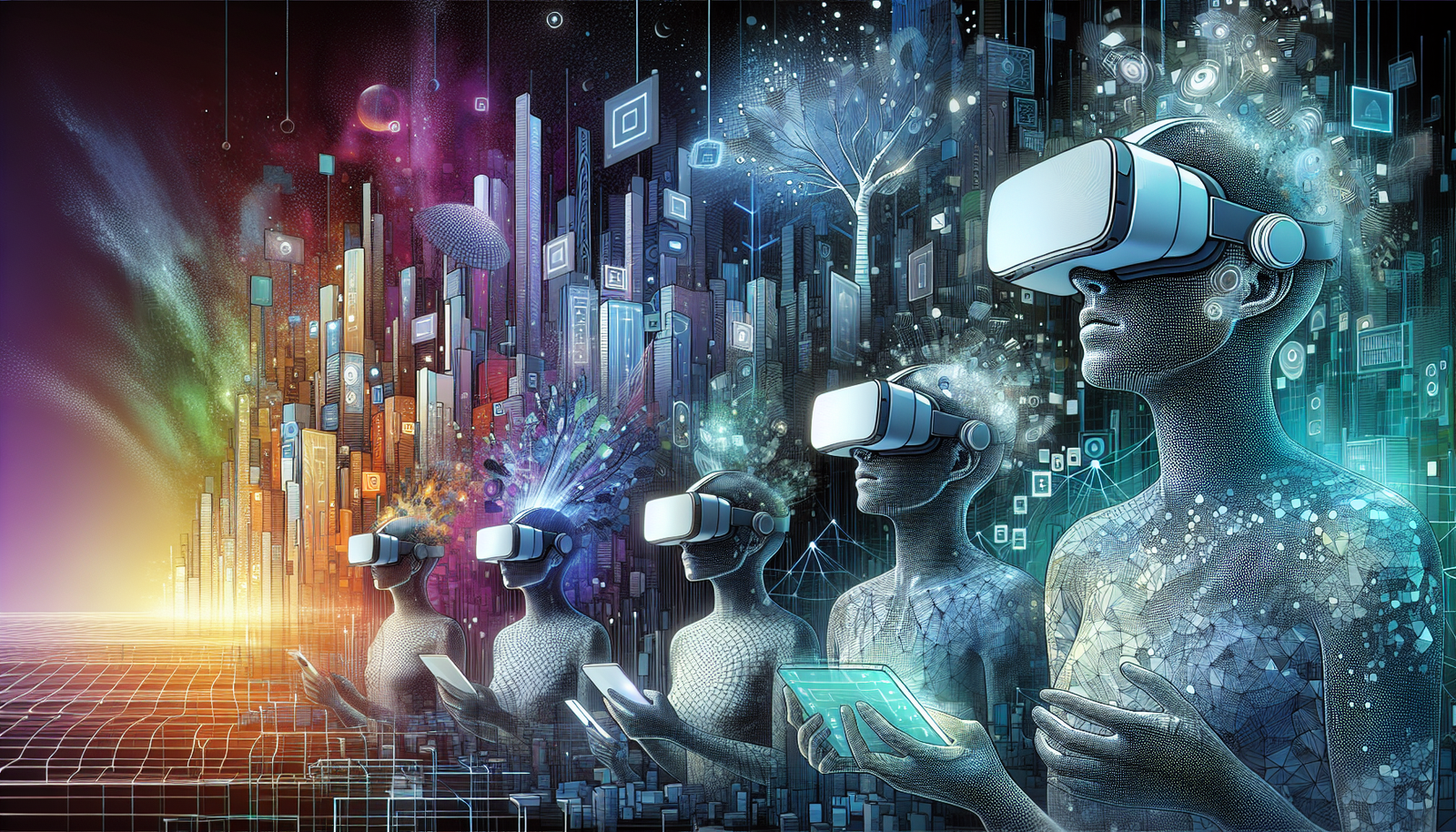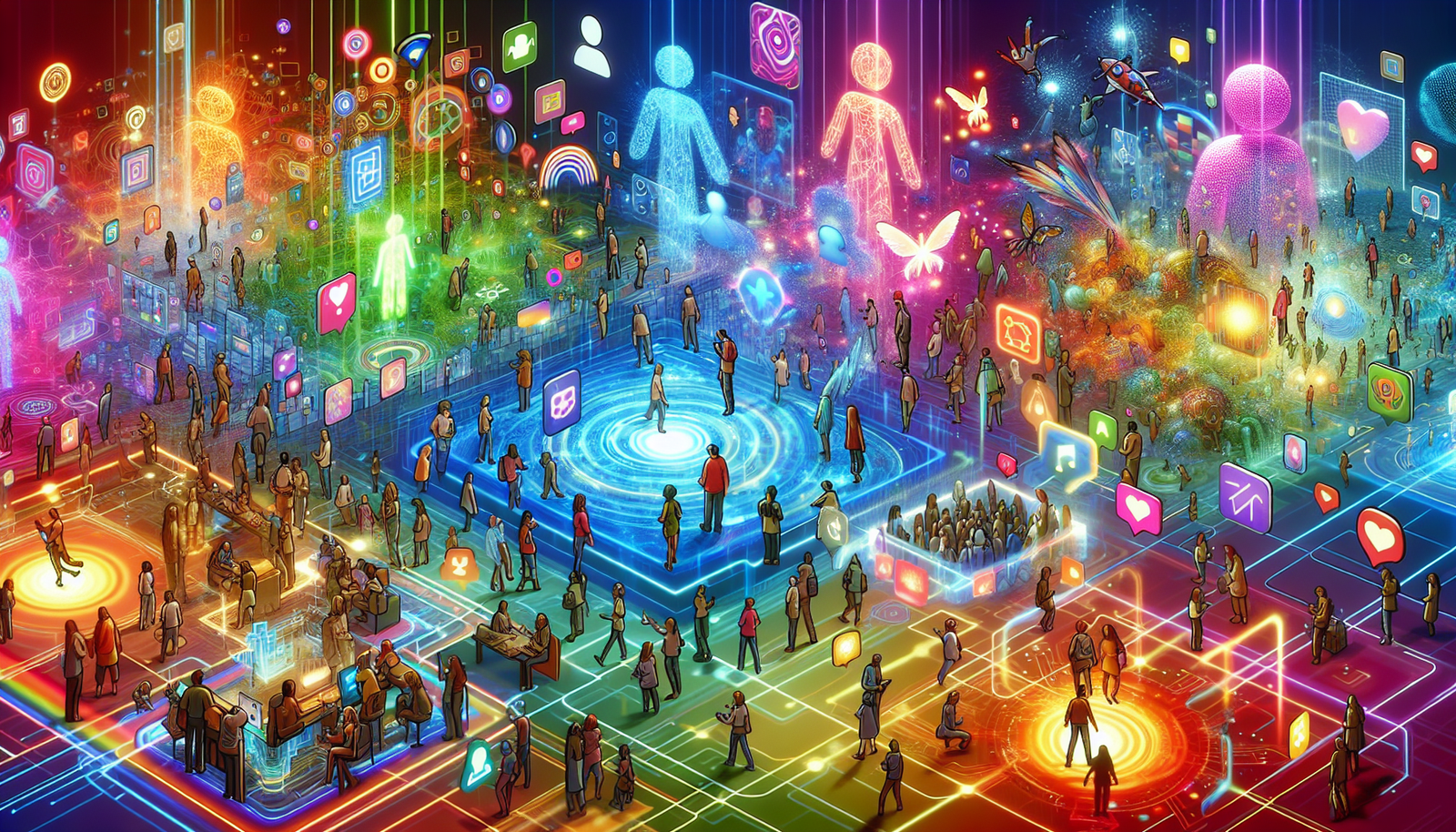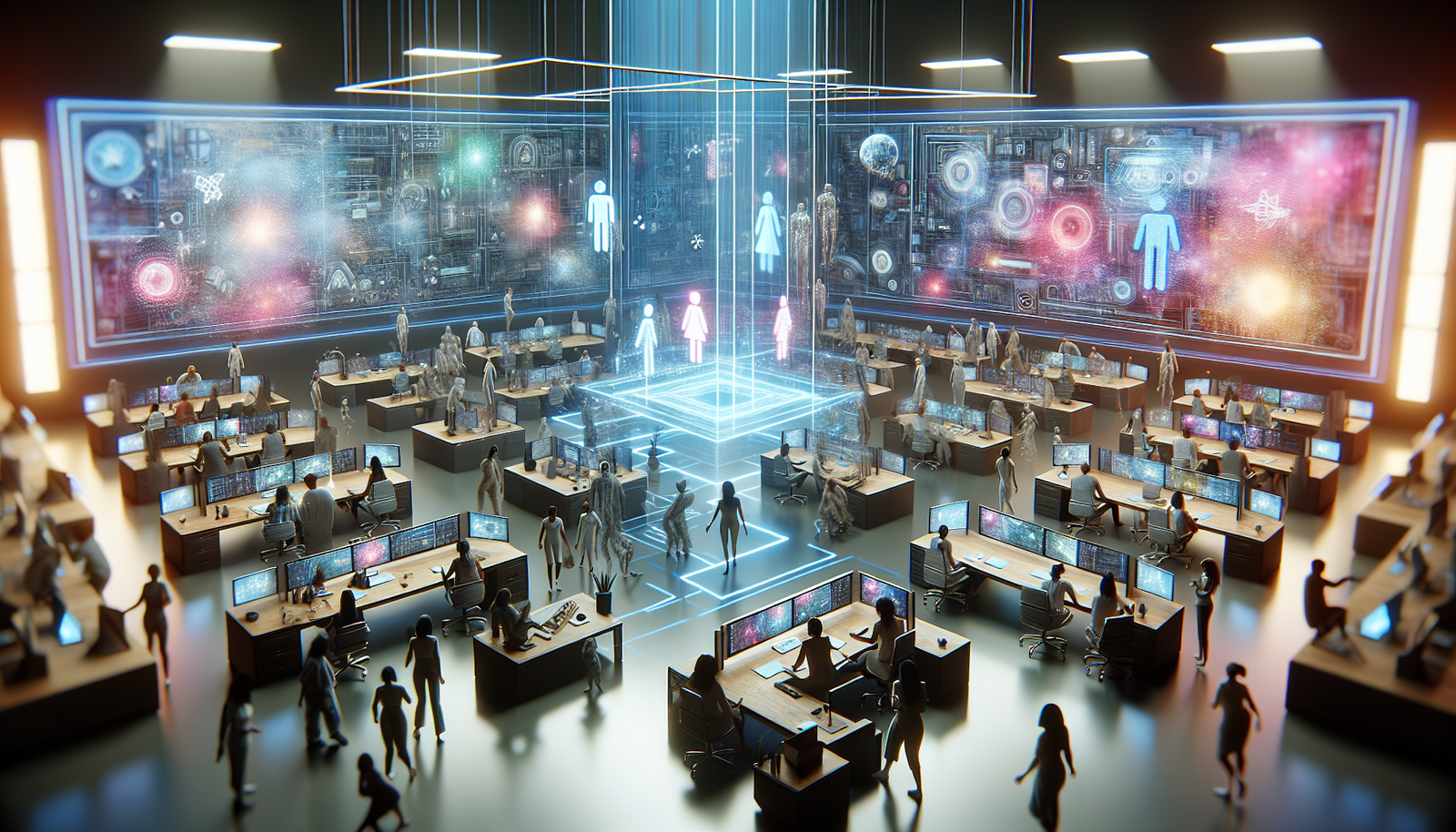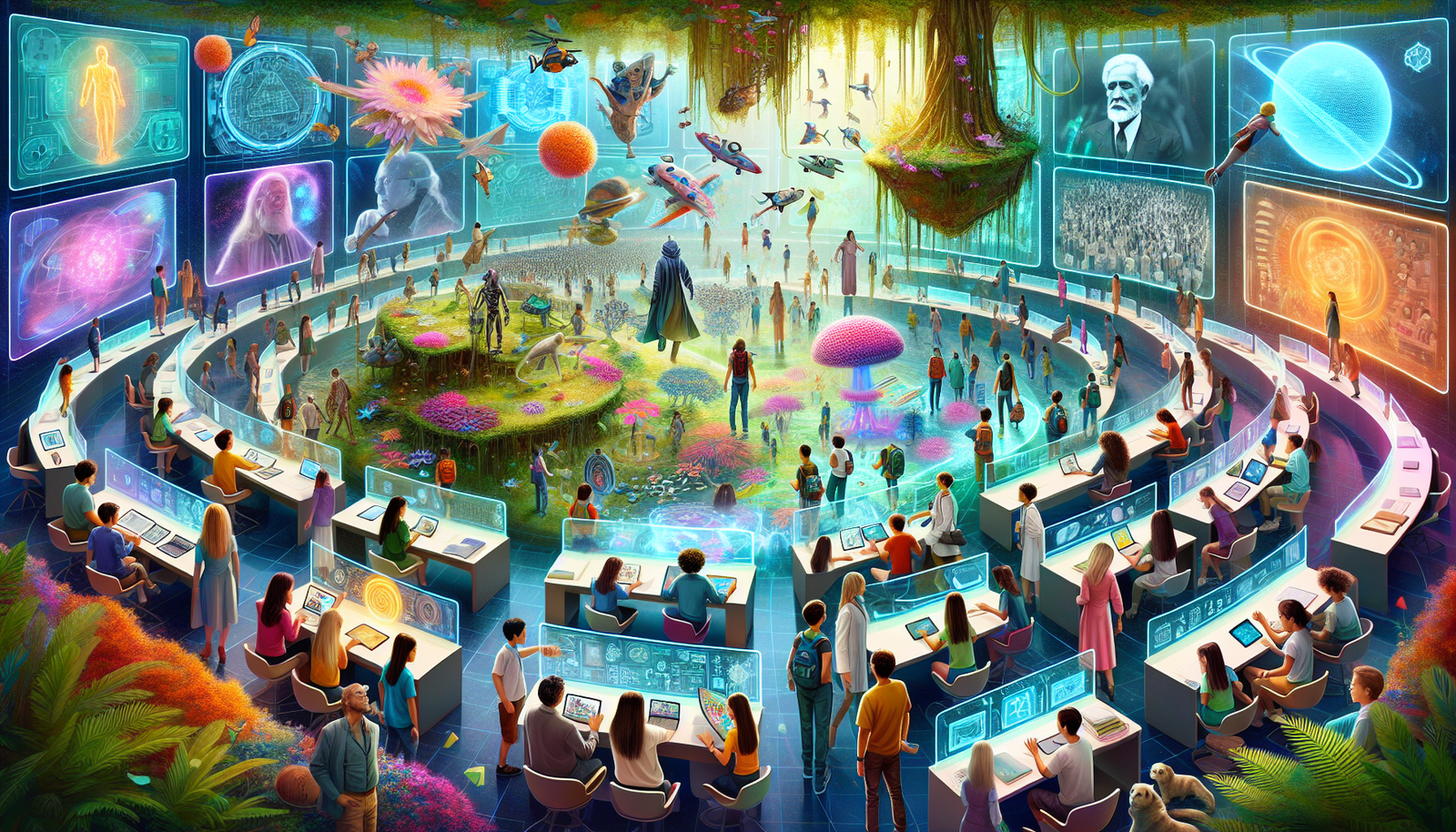Metaverse Meaning: Essential Guide for the Virtual Worlds
What exactly is the metaverse? In essence, it refers to a wide-ranging online world where people interact through digital avatars, blend the physical with the virtual via AR and VR, and create communities and economies that parallel our own. This article dives into the metaverse meaning, demystifying its functions and potential to reshape our digital interaction models, without spoiling the rich detail and insights to follow.
Key Takeaways
The metaverse concept, which includes VR, AR, and the internet, evolved from Neal Stephenson’s vision in his 1992 novel ‘Snow Crash’, into a blend of immersive virtual experiences and augmented physical reality, with VR enhancing a sense of presence and AR merging digital content with the real world.
The anatomy of the metaverse comprises seven layers that shape different aspects of user experience, with digital avatars serving as virtual identities, blockchain technology and devices like VR headsets forming the technological backbone, and interoperability between virtual spaces enriching user engagements.
The metaverse is anticipated to impact real-world economies, with its market value potentially reaching $5 trillion by 2030. It introduces new business models, combines digital currencies and decentralized governance, and fuels discussions about data privacy, user safety, and interoperability with Web 3.0.
Defining the Metaverse: Beyond Science Fiction

Neal Stephenson, an author, introduced the term ‘metaverse’ in his 1992 novel ‘Snow Crash,’ portraying it as the successor to the internet based on virtual reality. In the novel, the metaverse was envisioned as a collective virtual shared space, a convergence of virtually enhanced physical reality and persistently present virtual spaces. However, the concept of the metaverse has since expanded beyond Stephenson’s fictional representation to embrace a fusion of virtual reality (VR), augmented reality (AR), and the internet.
The Genesis of the Word Metaverse
Neal Stephenson, in ‘Snow Crash,’ used ‘metaverse’ to depict a shared virtual space that combines features of virtual reality (VR) and augmented reality (AR). The narrative presented a virtual urban environment where avatars of users interact in a three-dimensional space, marking the genesis of the term metaverse.
Virtual Reality and the Metaverse
Virtual reality technology is pivotal to the metaverse, offering immersive experiences that set it apart from digital environments facilitated by augmented and mixed reality. VR enhances a heightened sense of presence in the metaverse, allowing users to virtually meet friends and family, attend shows, and participate in shared experiences.
Beyond social interactions, virtual reality within the metaverse enhances user engagement by offering diverse gaming worlds and enabling innovative fitness experiences, such as the Supernatural virtual reality fitness service. Additionally, the metaverse provides virtual spaces for productive collaboration, leveraging VR to enable efficient work setups and smart office environments.
Augmented Reality: Merging Digital and Physical Worlds
Augmented reality (AR) employs technology to overlay computer-generated images on a person’s perception of reality, enabling a blend of physical and virtual experiences. In the metaverse, AR is anticipated to supplement users’ views of the real world with computer-generated imagery, creating a seamless blend of physical and virtual experiences.
Companies are leveraging augmented reality in the metaverse to let consumers virtually try on clothing or eyewear, visualize new furniture in their living spaces, or experiment with new hairstyles and cosmetics. This not only enhances user experience but also provides businesses with innovative ways to engage their customers.
Anatomy of the Metaverse: Understanding Its Core Components

Several layers that form its intricate structure shape the metaverse experience. Entrepreneur and author, Jon Radoff, identified seven distinct layers comprising the metaverse, each impacting a different aspect of the user experience.
The metaverse consists of four broad categories: Content and experiences, Platforms, Infrastructure and hardware, Enablers.
Crafting Identities: The Role of Digital Avatars
Within the metaverse, digital avatars serve as distinctive digital identities, embodying the physical or imaginative form of individual users. Avatars can express one’s emotions and feelings uniquely, often resembling their users’ real-life counterparts in some way.
The modification of avatars through gamification techniques creates an engaging and dynamic user experience. Lifelike avatars can increase immersion, making interactions within the metaverse feel more realistic. In the metaverse, users primarily communicate and interact through their visual representations – their avatars. Avatars serve as the main means of engagement and connection within the virtual environment.
Constructing Virtual Spaces

Intentionally created virtual spaces in the metaverse allow users to explore virtual worlds, socialize, engage in a broad range of activities, and be free from physical constraints.
The notion of virtual spaces within the metaverse stems from initial projects like Second Life, which, since its launch in 2003, has incorporated elements of social media into a persistent 3D world.
Designing virtual spaces with interoperability as a core goal allows users to have smooth transitions between various virtual worlds and platforms, enriching the metaverse experience. Examples of immersive virtual worlds, such as Decentraland, showcase how users can actively engage with the environment by buying, selling, and developing virtual land.
The Technological Backbone
VR and AR devices, 3D modeling software, and blockchain technology form the foundation of the metaverse, facilitating immersive virtual worlds. Microsoft’s Azure Spatial Anchors and industrial Metaverse framework, incorporating AI, ML, mixed reality, and cloud to edge services, are key examples of metaverse technology in development.
The metaverse is forecasted to drive significant changes in business operations through virtual representations, leading to innovative solutions to complex problems. Platforms like Nvidia Omniverse demonstrate the potential of merging 3D design, spatial computing, and physics-based workflows, all of which are crucial for creating and managing metaverse environments.
The Intersection of Metaverses and Real Economies
The potential impact of the metaverse economy, which could reach up to $5 trillion by 2030 – comparable to Japan’s economy, makes the confluence of metaverse and real-world economies a subject of significant interest. Venture capital investments into metaverse-related companies soared to approximately $10 billion in 2021, marking a more than threefold increase from the previous year.
The metaverse economy facilitates a transition from conventional financial systems to decentralized ecosystems through the integral use of digital currencies and blockchain technology. Economic activities within the metaverse have the potential to influence traditional economic structures, consumer behavior, and even global monetary policies.
The emergence of the metaverse economy prompts discussions about the coexistence and interaction of virtual spaces with physical world environments. The metaverse challenges traditional business models through innovations in:
E-commerce
Virtual real estate
Advertising
Professional training
The commerce market within the metaverse could be a major driver of value creation, with predictions pointing towards a market value of $507.8 billion and over 2.6 billion users by 2030.
Decentralized Autonomous Organizations (DAOs) in the metaverse use blockchain and smart contracts to democratically reach consensus on decisions, potentially reshaping governance models for economic entities.
Trading and Ownership of Digital Assets
Blockchain technology plays a crucial role in the metaverse, ensuring secure, decentralized, and transparent transactions. Non-fungible tokens (NFTs) serve as a proof of ownership for digital assets in the metaverse, anchored by blockchain technology. Virtual land acquisition in the metaverse uses cryptocurrencies and is solidified through NFTs, enabling various digital ventures like storefronts and entertainment.
Digital assets within the metaverse, including virtual real estate and other goods, can be commercialized via blockchain-based marketplaces. GameFi and Play-to-Earn are novel economic paradigms in the metaverse incentivizing players within gaming platforms. Platforms like Decentraland and The Sandbox highlight the successful integration of blockchain economies into metaverse ecosystems.
Looking ahead, the metaverse is envisioned as having a series of interconnected but independent virtual economies with the capacity for cross-platform asset transfers.
Generating Value in Virtual Markets

The metaverse introduces new business models, including opportunities to monetize virtual experiences, services, and products. Gamification and play-to-earn models are gaining momentum in the metaverse, potentially doubling in adoption.
The virtual environment of horizon worlds in the metaverse, without physical limitations, allows for expanded economic opportunities.
The Currency of the Metaverse
Most metaverse platforms predominantly use cryptocurrency to carry out transactions and acquire digital assets, usually providing free access to users. Ownership and economic transactions within the metaverse are greatly facilitated by NFT marketplaces and token economies, which serve as platforms for trading digital assets.
Web 3.0, with its emphasis on decentralization, blockchain technology, and cross-platform compatibility, provides a robust framework for the digital currencies used in the metaverse. This underscores the inherent interconnectivity of the metaverse and the real-world economy.
The Sociocultural Impact of the Metaverse
The evolution of the metaverse is expected to revolutionize our interactions, transactions, and coexistence, leading to profound sociocultural impacts. One emerging concept is ‘story living,’ where individuals become active participants in the narrative, influencing the storyline as it unfolds. This storytelling within the metaverse is a powerful tool for brands to increase awareness and build a more immersive and personal identification with their audience.
Education and Learning in the Metaverse

The metaverse offers a learning experience that includes:
Personalized education according to each student’s learning style and pace
Increased engagement and social interaction
Virtual field trips and vocational training within the metaverse
Access to simulated environments for firsthand experiences such as exploring historical sites or practicing surgical procedures
Students can benefit from these features and enhance their learning experience.
However, educational use of the metaverse requires addressing privacy concerns, ensuring that data protection and accessibility are integral to these innovative learning spaces.
Social Dynamics in Digital Spaces
The metaverse introduces new virtual venues for social interactions and shared experiences. Augmented reality in the metaverse allows the creation and sharing of experiences that reach a wide audience, fostering a sense of closeness among users.
This shared experience in the physical and digital worlds, particularly in a digital space, presents new dynamics in social interaction, shaping how we relate and engage with one another.
Privacy and User Safety Considerations
Despite the metaverse’s potential benefits, privacy and user safety concerns remain. These include tracking, the monetization of biometric responses such as facial expressions and heart rate, and the lack of established guardrails to protect users. Virtual reality and augmented reality headsets have the capacity to collect data on facial expressions, gaze direction, bodily gestures and movements, heart rate, and the content generated by users through AI.
The metaverse’s digital safety and privacy have been significant concerns, as evidenced by major data breaches affecting millions of individuals in 2020. New challenges for cybersecurity, privacy rights, and regulatory compliance are expected as the metaverse evolves, necessitating solutions that prioritize user control over their information, such as:
the implementation of ‘privacy by design’ principles
robust encryption protocols
secure authentication methods
transparent data collection and usage policies
These measures will help ensure a safer and more private metaverse experience for users.
Access Points: How to Enter the Metaverse
Environments such as Roblox, Decentraland, The Sandbox, Star Atlas, Illuvium, and Bloktopia serve as examples of entry points to the metaverse. Users can access the metaverse using a range of devices such as:
computers
tablets
mobile devices
VR headsets
smart glasses
depending on the requirements of various metaverse platforms.
From Mobile to Immersive Headgear
A variety of devices provide access to the metaverse, including:
VR headsets like the Oculus Quest 2
Computers
Smartphones
Game consoles
Mobile app platforms like Roblox
Additionally, augmented reality glasses, also known as smart glasses, offer a gateway into the metaverse with capabilities such as recording, overlaying AR elements, and sharing digital experiences.
Various interactive devices such as keyboards, mice, and joysticks are used to control digital avatars in the metaverse, with the design allowing for alternative interaction methods to accommodate users with disabilities. VR immersion is enhanced by specific hardware such as VR headsets, controllers, and haptic devices that provide tactile feedback, contributing to deeper engagement in virtual environments.
The Role of Interoperable Networks
The current form of the metaverse appears as a collection of distinct virtual worlds, each with its unique systems and limited interoperability. There is an aspiration within the metaverse community to develop standards that enable users to move seamlessly between different virtual worlds and applications using interoperable networks.
Web3 technologies may provide the necessary decentralized and user-empowered foundation to support the connectivity and interoperability of different metaverse environments. As an integral part of Web 3.0, the metaverse is expected to utilize principles like greater user control over data and governance, leveraging cutting-edge technologies to enhance user experience and connectivity.
The Corporate Horizon: How Tech Companies Are Shaping the Metaverse
Major players such as Meta Platforms, Google, and Microsoft are instrumental in shaping the metaverse, allocating resources and steering future directions. The incorporation of metaverse technology into various business sectors, such as virtual and augmented reality, industrial applications, and e-commerce, is gaining significant traction.
Enterprise metaverse applications offer the potential to simulate entire organizations and systems to pinpoint and rectify inefficiencies, reducing both errors and the need for rework. Microsoft’s development of the metaverse spans a number of divisions and products, including:
HoloLens
Microsoft Mesh
Xbox Cloud Gaming
Azure cloud services
Blockchain
AI and machine learning capabilities.
Amazon Web Services (AWS) supports the metaverse development by providing cloud services and technologies to extended reality companies, including Meta, Magic Leap, and Nvidia. Google is leveraging its expertise in AR/VR, spatial computing, cloud services, AI, machine learning, and content creation to contribute to the metaverse. This involvement is aimed at shaping the future of virtual experiences.
Meta Platforms and the Quest for a Fully Realized Metaverse
With a strategic focus on constructing a comprehensive metaverse, Mark Zuckerberg has rebranded Facebook as Meta Platforms. Zuckerberg envisions the metaverse as an embodied internet operated by different products and services, aiming to create a hyper-connected digital world. The initial phase of constructive components for Meta’s metaverse focuses on virtual reality, prioritizing the development of VR headsets and technologies.
Augmented reality is another cornerstone of Meta’s metaverse development, outlined by Zuckerberg as a transformative technology for future platforms. Meta has made significant investments to cultivate partnerships, such as acquiring companies with competencies in relevant technology, to boost its metaverse development efforts.
Google’s Mixed Reality Ventures
The discontinuation of Google Glass Enterprise Edition, an augmented reality wearable, signifies the end of an era for Google’s early AR hardware. However, Google is actively developing its metaverse initiative, Project Starline, which utilizes 3D immersive video chat technology to foster virtual social interaction and collaboration.
The acquisition of Raxium highlights Google’s ongoing investment into the necessary hardware to enhance AR/VR experiences, which are key components of metaverse technologies.
Microsoft’s Integration of Work and Play
Microsoft’s Mesh for Teams presents a mixed-reality platform that facilitates collaboration and meetings in the metaverse, effectively establishing a virtual office space. Dynamics 365 Connected Spaces offers insights for hybrid workspaces, showcasing Microsoft’s commitment to supporting virtual and mixed-reality business applications.
Xbox Cloud Gaming extends the Xbox experience to the metaverse, allowing gaming to be enjoyed in virtual environments. Microsoft’s mixed-reality platform, Microsoft Mesh, integrates with both consumer and enterprise applications, offering experiences that blend both productivity and entertainment. The acquisition of AltspaceVR supports Microsoft’s ambitions to expand social hubs in the metaverse where people can interact in virtual office spaces and entertainment venues.
The HoloLens 2 device is a tangible product of Microsoft’s mixed reality efforts, targeting enterprise and industrial use while also supporting gaming and entertainment. As Microsoft continues to develop seamless work and play integration, the boundaries between professional tools and entertainment options in the metaverse may further blur.
The Future Path of the Metaverse: Predictions and Possibilities
Blockchain, accelerated advancements in 5G, compute and network infrastructure, in tandem with progress in interface hardware, will propel the development of the metaverse. Most business leaders remain optimistic about the metaverse’s future, believing it will significantly impact the economy and their business success over the next decade.
Human-computer interaction is crucial for integrating user activities into the virtual world, assisting those who require formal training and information on how to connect with computing systems. Public interest in the metaverse is evidenced by the shifting behavior of customers who, in a recent survey, indicated a net increase in time spent online for various activities including:
Exercising
Working
Reading
Shopping
The future of reality, as envisioned by experts, is a blend of the real and the virtual, changing the way we perceive and interact with the world around us, including digital worlds.
Utopian Visions vs. Dystopian Concerns
The metaverse promises to revolutionize social connectivity by enabling individuals to:
Form relationships, unbounded by physical space and distance
Transcend geographical limitations
Democratize access to experiences and opportunities
Bridge gaps between different socioeconomic groups.
However, there are concerns that continuous digital surveillance could become a fundamental aspect of the metaverse, affecting user privacy. There is also a dystopian concern that the metaverse could enable new forms of addiction, leading to escapism and a preference for virtual interactions over real-life connections. Potential loss of individual freedoms and the creation of a ubiquitous digital footprint are also central to dystopian scenarios for the metaverse.
Yet, the metaverse offers new avenues for personal expression through avatars, potentially allowing individuals to explore and express their identities in ways not possible in the physical world.
The Evolution of Metaverse Technologies
Artificial intelligence and human-computer interaction are essential for the evolution of metaverse platforms, enhancing user experience and enabling more organic interaction within virtual spaces. Technologies such as:
Spatial computing
Digital humans
Shared experiences
Gaming
are projected to significantly influence future metaverse development.
Tokenization in the metaverse offers a new approach to asset ownership, allowing real-world assets to be converted into digital tokens, enhancing liquidity and making them more accessible. Microsoft aims to shape the industrial metaverse by integrating artificial intelligence and mixed reality to streamline operations, particularly for frontline workers.
Summary
Navigating through the virtual landscape of the metaverse, we’ve explored its origins, structure, economic implications, sociocultural impact, and access points. We’ve also delved into the significant role tech giants like Meta Platforms, Google, and Microsoft play in shaping the metaverse.
As we look to the future, the metaverse presents a blend of opportunities and challenges. While it holds the potential to revolutionize social connectivity and democratize access to experiences, concerns surrounding user privacy, potential addiction, and the loss of individual freedoms persist. However, with continued advancements in technology and thoughtful governance, the metaverse can become an integral part of our digital future, transforming the way we perceive and interact with the world around us.
Frequently Asked Questions
What is the metaverse?
The metaverse is a virtual reality space where users can interact with a computer-generated environment and other users, which combines virtually enhanced physical reality and persistently existing virtual spaces.
How can one access the metaverse?
To access the metaverse, you can use devices like computers, tablets, VR headsets, and smart glasses, depending on the platform’s requirements. Choose the device that suits your needs best.
What role do digital avatars play in the metaverse?
Digital avatars in the metaverse serve as unique digital identities representing users, allowing them to express emotions and feelings and often resembling their real-life counterparts in some way. Therefore, they play a crucial role in personal expression and representation in the virtual world.
How does the metaverse economy work?
The metaverse economy operates through the use of digital currencies and blockchain technology, which enable decentralized ecosystems and new economic activities such as trading and ownership of digital assets. This has the potential to impact traditional economic structures and global monetary policies.
What are the potential benefits and drawbacks of the metaverse?
The potential benefits of the metaverse include revolutionizing social connectivity and democratizing access to experiences, while drawbacks such as digital surveillance, potential addiction, and loss of individual freedoms are also prevalent. Be mindful of these factors when considering the metaverse.

Pingback: How Compagny Expand Reach via AI Influencers